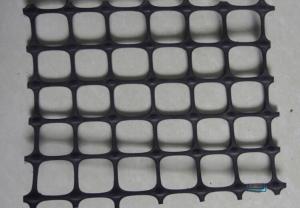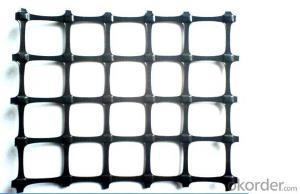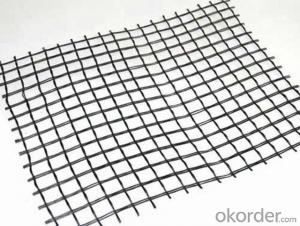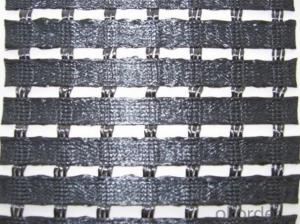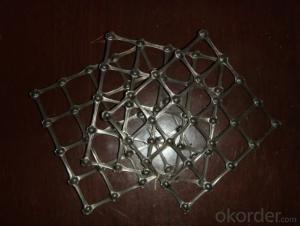Polypropylene Biaxial GeoGrid with CE Certificate with High Tear-resistance for Soil Reinforcement
- Loading Port:
- China Main Port
- Payment Terms:
- TT or LC
- Min Order Qty:
- 5000 Square Meters m²
- Supply Capability:
- 122000 Square Meters m²/month
OKorder Service Pledge
OKorder Financial Service
You Might Also Like
Polypropylene Biaxial GeoGrid with CE Certificate with High Tear-resistance for Soil Reinforcement
1. Introudction for Polypropylene Biaxial GeoGrid with CE Certificate with High Tear-resistance for Soil Reinforcement
Plastic earthwork grid is a drawing of a square or rectangle of polymer mesh material, according to its manufacture different stretching direction can be unidirectional and bi-stretch. It is in the extruded polymer sheets (raw materials for PP or HDPE) punch, and heating purposes of directional stretch. Unidirectional grid only stretch along plate length direction, which is biaxially oriented grid continues to be one of the grid and then in the direction of its length vertical stretch.
2. Features for Polypropylene Biaxial GeoGrid with CE Certificate with High Tear-resistance for Soil Reinforcement
a). Low Elongation
b).High Tensile Strength
c). Warp / Weft: tensile strength(kn/m): 15,20, 30, 40, 50
d). High Tear-resistance
3. Specifications and Technical Data for Polypropylene Biaxial GeoGrid with CE Certificate with High Tear-resistance for Soil Reinforcement
Index Properties | Test Method | Unit | GG1515 | GG2020 | GG3030 | GG4040 |
MD TD | MD TD | MD TD | MD TD | |||
Polymer | -- | -- | PP | PP | PP | PP |
Minimum Carbon Black | ASTM D 4218 | % | 2 | 2 | 2 | 2 |
Tensile Strength@ 2% Strain | ASTM D 6637 | Kn/m | 5 5 | 7 7 | 10.5 10.5 | 14 14 |
Tensile Strength@ 5% Strain | ASTM D 6637 | Kn/m | 7 7 | 14 14 | 21 21 | 28 28 |
Ultimate Tensile Strength | ASTM D 6637 | Kn/m | 15 15 | 20 20 | 30 30 | 40 40 |
Strain @ Ultimate Strength | ASTM D 6637 | % | 13 10 | 13 10 | 13 10 | 13 10 |
Structural Integrity | ||||||
Junction Efficiency | GRI GG2 | % | 93 | 93 | 93 | 93 |
Flexural Rigidity | ASTM D 1388 | Mg-cm | 700000 | 1000000 | 3500000 | 10000000 |
Aperture Stability | COE Method | mm-N/deg | 646 | 707 | 1432 | 2104 |
Dimensions | ||||||
Roll Width | -- | M | 3.95 | 3.95 | 3.95 | 3.95 |
Roll Length | -- | M | 50 | 50 | 50 | 50 |
Roll Weight | -- | Kg | 39 | 50 | 72 | 105 |
MD denotes Machine direction. TD denotes transverse direction. | ||||||
4. Some photos for Polypropylene Biaxial GeoGrid with CE Certificate with High Tear-resistance for Soil Reinforcement
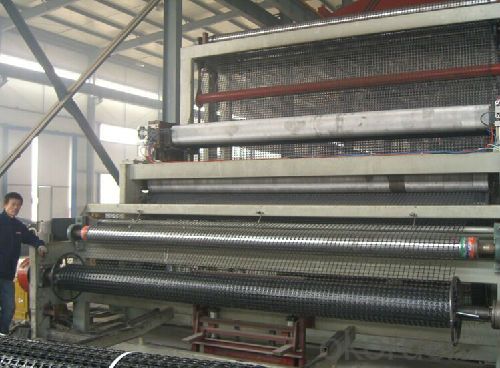
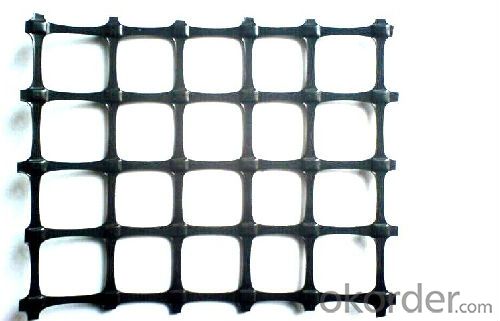
- Q:How do geogrids improve the performance of geocell-reinforced slopes for erosion control?
- Geogrids improve the performance of geocell-reinforced slopes for erosion control by providing additional strength and stability. They help distribute the load evenly across the slope, preventing soil movement and reducing erosion. Additionally, geogrids increase the frictional resistance between soil layers, enhancing the overall slope stability and preventing soil slippage.
- Q:What are the factors affecting the design of geogrid-reinforced structures?
- The factors affecting the design of geogrid-reinforced structures include the type and properties of the soil, the load and magnitude of the forces acting on the structure, the desired level of stability and performance, the site conditions and constraints, and the specific design standards and guidelines applicable to the project.
- Q:How do geogrids improve the performance of reinforced soil structures?
- Geogrids improve the performance of reinforced soil structures by providing additional strength and stability. They act as a reinforcement material, distributing the forces and loads evenly throughout the structure. This helps to prevent soil erosion, slope failure, and settlement, ultimately enhancing the overall durability and longevity of the structure.
- Q:Can geogrids be used in retaining wall drainage systems?
- Yes, geogrids can be used in retaining wall drainage systems. Geogrids provide reinforcement to the soil and help to prevent soil erosion and slippage. They can be used to enhance the stability and longevity of retaining walls by improving the drainage system, reducing hydrostatic pressure, and allowing water to flow through the soil behind the wall.
- Q:How do geogrids enhance soil reinforcement?
- Geogrids enhance soil reinforcement by providing additional tensile strength and stability to the soil. They are placed within the soil layers and act as a reinforcement material, distributing the forces and reducing the potential for soil movement. This helps to increase the overall strength and performance of the soil, making it more resistant to erosion, deformation, and other types of failures.
- Q:PA66 plus 30% glass Shrink is how much
- PA66 plus 30% glass fiber shrinkage 0.7%--1.0%, different brands of different manufacturers of some differences.
- Q:Are geogrids suitable for use in ground reinforcement for agricultural facilities?
- Yes, geogrids are suitable for use in ground reinforcement for agricultural facilities. Geogrids provide effective soil stabilization, erosion control, and load-bearing capabilities, making them ideal for reinforcing agricultural areas such as access roads, parking lots, and storage areas. They help distribute the load evenly, prevent soil compaction, and improve overall drainage, resulting in increased durability and longevity of the facilities.
- Q:Geogrid tgsg45-45 what does it mean
- Geogrid TGSG45-45, two-way plastic geogrid 45KN, I hope to help you.
- Q:What are the application of Geogrid in the construction of cement concrete pavement
- Can effectively prevent the generation of concrete through cracks
- Q:The difference between geocell and geogrid
- The geocell is a kind of three-dimensional grid chamber structure, which is formed by the high strength welding of the HDPE material. Generally welded by ultrasonic needle. Due to the need of the project, some of them are punched on the diaphragm.
1. Manufacturer Overview |
|
|---|---|
| Location | 示范:Hebei, China |
| Year Established | 示范:1997 |
| Annual Output Value | 示范:Above US$50 Million |
| Main Markets | 30.00% South America; 20.00% North America; 15.00% Eastern Europe; 15.00% Southeast Asia; 10.00% South Asia; 5.00% Southern Europe; 5.00% Africa |
| Company Certifications | ISO 9001:2008 |
2. Manufacturer Certificates |
|
|---|---|
| a) Certification Name | |
| Range | |
| Reference | |
| Validity Period | |
3. Manufacturer Capability |
|
|---|---|
| a)Trade Capacity | |
| Nearest Port | Tianjin;Qingdao;Shanghai |
| Export Percentage | |
| No.of Employees in Trade Department | 21-50 People |
| Language Spoken: | English;Chinese |
| b)Factory Information | |
| Factory Size: | Above 100,000 square meters |
| No. of Production Lines | Above 12 |
| Contract Manufacturing | OEM Service Offered;Design Service Offered |
| Product Price Range | High;Average |
Send your message to us
Polypropylene Biaxial GeoGrid with CE Certificate with High Tear-resistance for Soil Reinforcement
- Loading Port:
- China Main Port
- Payment Terms:
- TT or LC
- Min Order Qty:
- 5000 Square Meters m²
- Supply Capability:
- 122000 Square Meters m²/month
OKorder Service Pledge
OKorder Financial Service
Similar products
New products
Hot products
Related keywords
